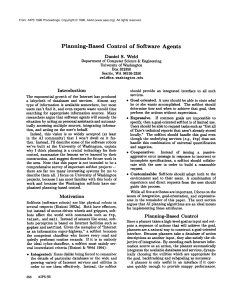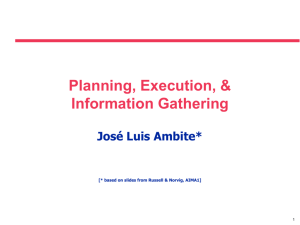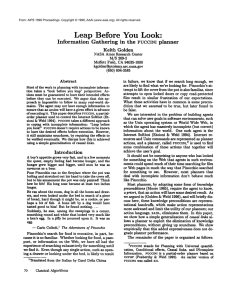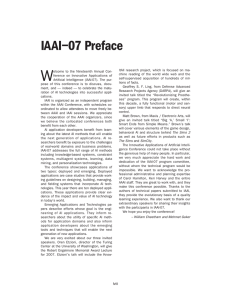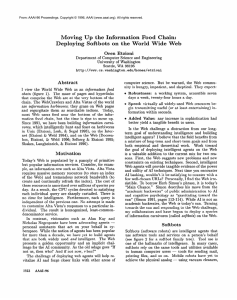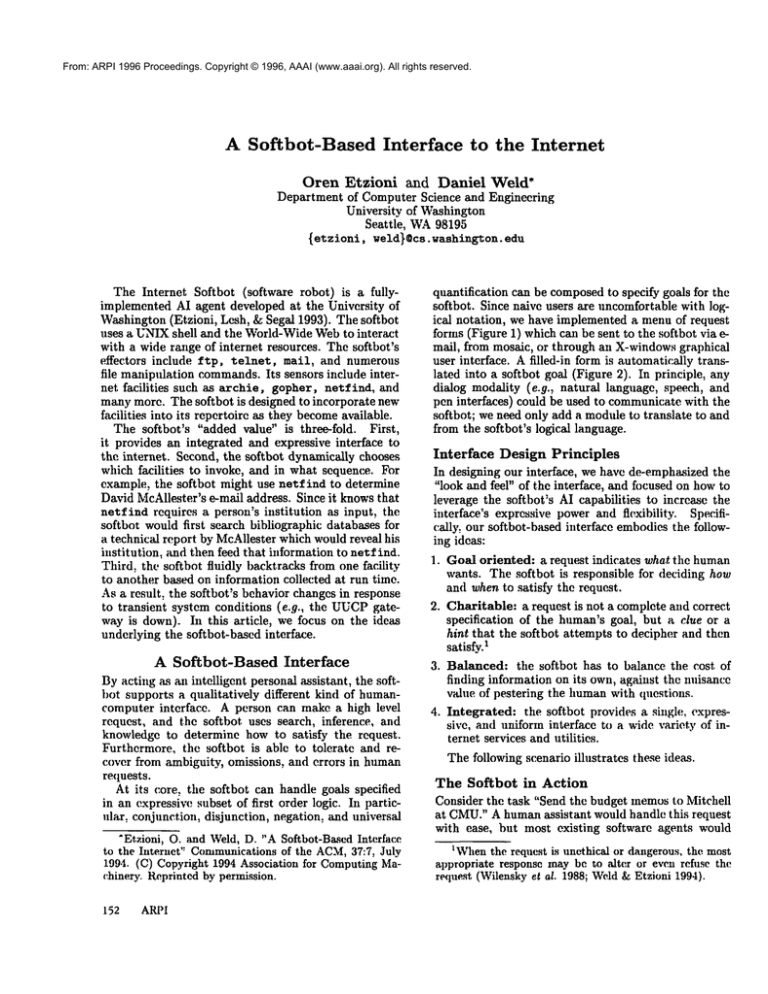
From: ARPI 1996 Proceedings. Copyright © 1996, AAAI (www.aaai.org). All rights reserved.
A Softbot-Based
Interface
to the Internet
Oren Etzioni and Daniel Weld*
Department of Computer Science and Enginecring
University of Washington
Seattle, WA98195
{etzion±,weld}@cs.washing%on.edu
The Internet Softbot (software robot) is a fullyimplemented AI agent developed at the University of
Washington (Etzioni, Lcsh, & Segal 1993). The softbot
uses a UNIXshell and the World-WideWebto interact
with a wide range of internet resources. The softbot’s
effectors include ftp, telnet, mail, and numerous
file manipulation commaslds. Its sensors include internet facilities
such as archie, gopher, netfind, and
manymore. The softbot is designed to incorporate new
facilities into its repertoirc as they becomeavailable.
The softbot’s "added value" is three-fold. First,
it provides an integrated and expressive interface to
the internet. Second, the softbot dynamically chooses
which facilities to invoke, and in what sequence. For
example, the softbot might use netfind to determine
David McAllester’s e-mail address. Since it knowsthat
netfind requires a person’s institution as input, the
softbot would first search bibliographic databases for
a technical report by McAllester which would reveal his
institutkm, and then feed that information to netfind.
Third, the softbot fluidly backtracks from one facility
to another based on information collected at run time.
As a result., the softbot’s behavior changes in response
to transient system conditions (e.g., the UUCPgateway is down). In this article, we focus on the ideas
underlying the softbot-based interface.
A Softbot-Based Interface
By acting ,~s all intelligent personal assistant, the softbot supports a qualitatively different kind of humancomputer interface. A person can make a high level
request, and the softbot uses search, inference, and
knowledge to determine how to satisfy the request.
Furthermore, the softbot is able to toleratc and recover from ambiguity, omissions, and errors in human
requests.
At its core, the softbot can handle goals specified
in an expressiw’ subset of first order logic. In particular., conjunction, disjunction, negation, and universal
"Etzioni, O. ~mdWeld, D. "A Softbot-Ba.scd Interface
to the Internet" Communicationsof the ACM,37:7, July
1994. (C) Copyright 1994 Association for ComputingMachinery. Reprinted by permission.
152
ARPI
quantification can be composedto specify goals for the
softbot. Since naive users are uncomfortable with logical notation, we have implemented a menu of request
forms (Figure 1) which can be sent to the softbot via
mail, from mosaic, or through an X-windowsgraphical
user interface. A filled-in form is automatically translated into a softbot goal (Figure 2). In principle, any
dialog modality (e.g., natural language, speech, and
pen interfaces) could be used to communk:atewith the
softbot; we need only add a moduleto translate to and
from the softbot’s logical language.
Interface
Design Principles
In designing our interface, we havc de-emphasized the
"look and feel" of the interface, and h~cused on howto
leverage the softbot’s AI capabilities to incrcase the
interface’s expressive power and flexibility. Specifically., our softbot-based interface embodiesthe following ideas:
1. Goal oriented: a request indicates what the human
wants. The softbot is responsible for deciding how
and when to satisfy the request.
2. Charitable: a request is not a complete and correct
specification of the human’s goal, but a clue or a
hint that the softbot attempts to decipher and then
satisfy}
3. Balanced: the softbot has to balance the cost of
finding information on its own, against the mlisancc
vahm of pestering the humanwith questions.
4. Integrated: the softbot provides a single, expressive, and uniform interface to a wide variety of internet services and utilities.
The following scenario illustrates these ideas.
The Softbot
in Action
Consider the task "Send the budget memosto Mitchell
at CMU."A humanassistant would handh: this request
with ease, but most existing software agents would
lWhenthe request is unethical or dangerous, the most
appropriate responsc maybe to ,’tltcr or even refuse the
request (Wilenskyet al. 1988; Weld&Etzioni 1994).
From: ARPI 1996 Proceedings. Copyright © 1996, AAAI (www.aaai.org). All rights reserved.
Send Document
LastName
B~
M£tchell
G~
H~
L~
Limit
Pa~dlz
R~mo
I I
FigureI: Therequest
formfor sending
a document.
Notehowthegraphical
interface
supports
thelogical
powerof
universal
quantification
(alldocuments)
andnegation
("draft"
notpresent
as a string
in thefile).
Ingeneral,
users
needonlyprovide
a partial
specification
of thedesired
goal.Thesoftbot
disambiguates
therequest
andplanshow
to achieve
it,subgoaling
andbacktracking
as required.
not. Even if one solves (or circumvents) the problem
of natural-language understanding, the agent still has
to figure out:
The softbot’s first task is disambiguation. It has to
decide what "objects" the request is referring to: for
instance, whois the intended recipient of the memos?
The request suggests that the memosought to go to
¯ Which Mitchell was intended?
a person named Mitchell at CMU,but there may be
¯ Which document should I send?
several people at CMUthat share the same last name.
The softbot could adopt the policy of asking the hu(and where is it located?)
man to specify the recipient more clearly wheneverhis
¯ How do I send the memos?
fullnameis notprovided,
butthisis inappropriate.
A
(e-mail, fax, remote printing, etc.)
lastnamecouldpotentially
pickouta uniqueindivid¯ What if the memosare confidential?
ual.For example,
supposethe lastnameprovidcd
is
"Satyanarayanan."
In
this
case,
the
softbot’s
request
¯ Whatif Mitchell
is outof town?
forclarification
wouldbe gratuitous
andannoying.
In
As thissimpleexampleillustrates,
evenmundane
general,
anydescription,
however
tenuous,
mightpick
humanrequests
axeincompletely
specified,
potentially outa uniqueindividual.
Beforeaskingquestions,
the
softbot
oughttocheckwhether
thegivendescription
is
ambiguous,
or evenimpossible
to satisfy
(whatif there
ambiguous.
is no Mitchell
at CMU?).
Etzioni
153
From: ARPI 1996 Proceedings. Copyright © 1996, AAAI (www.aaai.org). All rights reserved.
(forall(?d :in files)
(if (and (file.type?d memo.document)
(subject.of.document
?d "budget")
(not (strinE.in.file
"draft"?d)))
(delivered.to
?d ?obj341)))
Figure 2: The form shown in Figure 1 is automatic:ally translated into an internal representation like the
one shown here. During this process, the softbot executes actions as needed in order to find a unique person
object (i.e., ?obj341) with last name "Mitchell" and
institution "CMU".Next the softbot planner will determine how to achieve the delivery goal.
Thesoftbot
couhlconsult
itsknowledge
baseto see
how manyMitchells
it "knows"at CMU,but suppose
thatthesoftbot
is familiar
withonlyone,canit be
surethatit is familiar
withalltheMitcheUs
at CMU?
Si.ceitsknowledge
of peopleon theinternet
is bound
to be radically
incomplete,
thesoftbot
cannot
afford
to
make the closed world assumption made by many AI
and database systems (Reiter 1978). Titus, it cannot
~mtomatically conclude that there is only one Mitchell
at CMUfrom the fact that it is familiar with only
one. Fortunately, it is easy to find all the Mitchells at
CMU(by executing finger mitchell@cmu, edu). The
softbot executes this command, records who are the
various Mitchells at CMU,and (if necessary) prompts
the humanwith a request to choose the intended one.
The softbot also records, for future reference, that it is
nowfamiliar with all the Mitchells at CMU.Despite its
incomplete knowledge, the softbot can recognize when
it has complete information on a particular topic or
locale (Etzioni, Golden, & Weld 1994).
To resolve ambiguity, the softbot could try to infer
who the intended Mitchell is, based on the documents
being sent and the context of the request (e.g., did
the human just receive an e-mail message from some
Mitchell at CMU?).While plausible inference of this
sort can be encoded within our softbot framework, our
implementation is not that sophisticated,
yet. Currently, the softbot attempts to find ’all individuals or
objects on the intcrnet matching a given description.
If there is a single resource that provides this information, the softbot will access it (e.g.: finger in the
above example). Otherwise, the softbot will form
plan to seek out matching individuals. If the description is not constrained appropriately, executing such
a plan can be very expensive. For instance, suppose
the humanomits Mitchell’s location in the above request. The softbot would be "tempted" to search the
entire internet looking for Mitchells. However,the balance principle implies that the softbot wouldbe better
off asking the human to further constrain Mitchell’s
description. Thus, before disambiguating, the softbot
estimates the cost of its disaznbiguation plan. When
the cost is high, the softbot prompts the human for
154
ARPI
more information: "I am not sure which Mitchell you
mean, can you tell me Mitchell’s workplace, city, or
field of interest?"
Once the appropriate Mitchell (and memos) have
been determined, the softbot’s second task is to actually send the memosto Mitchell. The softbot may
decide to e-mail the memos, but first it has to find
Mitchell’s e-mall address, and reason about doc,ment
format. For example, if a document contains figures,
then sending the postscript version is more appropriate than sending the ISTEXsource, l~lrthermore, if
Mitchell is out of town, or if the memosare confidential, the softbot has to ensure that the memosreach
their recipient in a timely and secure manner.
In general, after the softbot has figured o,t what the
humanwants, it considers howto satisfy the humanrequest. The softbot solves this problem by invoking an
automatic planning algorithm. Wedescribe our softbot’s planning capabilities in the next section.
Softbot
Planning
To construct an integrated and goal-oriented interface,
we use AI planning techniques. The softbot planner
takes a logical expression describing the user’s goal as
input. After searching a library of action schemata d~
scribing available information sources, databases, utilities and software commands,the planner dynamically
generates a sequence of actions that achieve the goal,
backtracking and subgoaling as necessary.
Unlike standard programs and scripts which are
committed to a rigid control flow determined a priori
by a programmer, the softbot’s planner automatically
synthesizes and executes plans to achieve the goals
which were input. This avoids the problematic task of
writing programs that anticipate all possible changes
in system environment, network status, and error conditions. In short, a softbot is worth a thousand shell
scripts.
The softbot’s planner accepts an expressive goal language, enabling the softbot to accept goals containing complex combinations of conjunction, disjunction,
negation, and nested universal a~ld existential quantification. Furthermore, the softbot’s use of planning
yields an integrated interface -- users can write expressive goals, even when dealing with services that
don’t support them directly. Consider the task "Get
all of Ginsberg’s technical reports that aren’t already
stored locally." Through planning, the softbot can use
ftp to handle this request, even though the ftp utility
doesn’t knowwhich files are local, and does imt handle
this combination of universal quantification and negation. The softbot will determine which of Ginsberg’s
reports
.axenotstored
locally,
andwillissueftpcommandsto obtainthem.
Thesoftbot
planner
is implemented
as a searchprocessoverpartially
specified
actionsequences
called
plans.The planneris able to decomposecomplex
goalexpressions
intotheirconstituents
andsolvethem
From: ARPI 1996 Proceedings. Copyright © 1996, AAAI (www.aaai.org). All rights reserved.
with divide and conquer techniques. Interactions between subgoals are automatically detected and resolved. Space precludes comprehensive discussion of
the algorithm (see (Weld 1994; Golden, Etzioni,
Weld 1994; 1996)); however, we note that modern planning algorithms are provably:
¯ Complete: if a plan exists, the planner will find it,
and
¯ Sound: if the planner outputs a plan, that plan is
guaranteed to achieve its goal (modulo certain explicit assumptions).
While these formal guarantees do not ensure that
the planner is efficient, we have not found efficiency to
be a problem in practice. The softbot planner accepts
control heuristics, specified in a high-level, declarative
language, which constrain the planner’s search by instructing it to prefer certain options over others, avoid
blind alleys, etc.. These heuristics can be hand-coded
or generated automatically via machine learning techniques (Etzioni 1993b; Minton 1990).
Wenow consider the benefits derived from the softbot’s use of a modern planning algorithm.
Subgoaling
If thesoftbot
cannot
satisfy
itsgoaldirectly,
it will
automatically
ssbgoaion an indirect
wayof satisfying the goals.For example,
if lookingup the phone
numberof a graduate
studentfails,thesoftbotwill
subgoal
on identifying
thestudent’s
office-mates
and
findingtheirphonenumber.
Thesoftbotrelieson an
inference
rulewhichstates
thatoffice-mates
sharethe
sametelephone.
Resource Integration
Theplanner
relies
on a logical
modelof theavailable
internet
resources,
whichanswers
twoquestions:
how
canthesoftbot
invoke
or access
theresource,
andwhat
istheeffect
of doingso?Thissortof "resource
model"
canbe viewedas a generalization
of a Prologinferenceruleto allowformultiple
effects,
nested
universalandexistential
quantification,
andstatechange.
The precisesyntaxandsemantics
of ourrepresentationlanguage
aredescribed
in (Etzioni
et al. 1992;
Etzioni,
Golden,& Weld1994).
Thisdeclarative
representation
enables
thesoftbot
tointegrate
multiple,
independent
internet
facilities
in
service of its goal. For instance, as mentionedin the introduction, the softbot’s model of netfind (Figure 3)
tells it that it has to knowa person’s institution (or
city) before accessing the netfind facility. Thus when
necessary, the softbot subgoals on finding this information by invoking different facilities (e.g., it might access the INSPECdatabase or grep through local bibliographic databases). Furthermore, the softbot is poised
to leverage new internet resources. Whena new facility
becomesavailable, we need only write the appropriate
logical models and search control rules to update the
softbot. Weare also investigating the use of learning
techniques to help automate this task.
Incomplete
Specification
~ Search
The softbot accepts incompletely specified goals, and
searches for missing information whenever possible.
For example,if asked to print a file on "any free printer
in the building," the softbot will find the printer list
in a database, and will check the status of each printer
until it finds one that is free. Similarly, if a humanasks
to be notified when Etzioni logs in to some machine at
the University of Washington, the softbot will search
for machines where Etzioni has an account and will
monitor these machines until he appears. In general,
the softbot’s goal language allows the humanto state
three kinds of goals:
¯ Ground goals: notify me when Etzioni logs in to the
machine called June.cs.washington.edu.
¯ Existentially quantified goals: notify me when Etzioni logs in to some machine.
¯ Constrained goals: notify me when Etzioni logs in
to some computer-science machine at the University
of Washington.
Empirically, we have found that constrained goals
strike a useful balance between burdening the user with
endless questions, and sending the softbot on a massive
search of the internet.
The use of a modern algorithm for planning with
incomplete information is one of the most distinctive features of our softbot. In contrast, much of
the current work on intelligent software agents focuses
on task-specific "bots" for visitor scheduling (Kautz
et al. 1994), meeting scheduling (Dent et al. 1992), email filtering (Maes & Kozierok 1993), white-page services (Droms1990), etc. While each of these agents has
its strengths, none share the benefits of the planning
approach including a highly expressive goal language,
automatic backtracking and subgoaling, and more.
Softbot
Safety
We’ve argued that in order to provide an integrated,
goal-oriented interface, one needs powerful tools such
as the softbot. However, the softbot also requires
safety features. Of course, this is true of any software tool (e.g., the Macintoshrefuses to reformat one’s
startup disk), but safety is more important for more
powerful tools. Just as in the carpentry domain (where
a table saw can slice through a tendon), internet power
tools, like the softbot, are capable of inflicting damage
when used indiscriminately.
The greatest danger lies in the softbot’s very ability to plan howto achieve the user’s goal. Note that
using a sound planner (i.e., one that only generates
plans which are guaranteed to achieve the goal) is not
sufficient, since there maybe msny such plans with different side effects. Consider the task "Reducedisk utiEtzioni
155
From: ARPI 1996 Proceedings. Copyright © 1996, AAAI (www.aaai.org). All rights reserved.
Name:
(netfind ?person)
Preeonds:
Postconds:
(current.shell
csh)
(userid?person!userid)
(person.machine
?person!machine)
(isa netfind.server
?server)
(firstname?person?firstname)
(lastname?person?lastname)
(or (person.city?person?keyword)
(person.institution
?person?keyword))
Figure 3: An action schema encoding the netfind utility; the softbot planner uses the schemata to determine when
an internet service could help achieve a user goal. The disjunctive precondition encodes the fact that netfind
requires the person’s institution or city to constrain its search. The softbot subgoals on obtaining that information
from a distinct information source. See (Etzioni et al. 1992; Golden, Etzioni, & Weld 1994; 1996) for the precise
syntax and semantics of our representation language.
lization
below90%."If thesoftbot
succeeded
by deletingirreplaceable
LATEXfileswithout
backing
themup
to tape,thenusersmightprefer
less"powerful"
tools!
We believethatthe softbot’ssafetymechanism
should
ensure
thefollowing
qualities:
* Safe=thesoftbot
shouldrefuseto makedestructive
changes
to theworld.
¯ Tidy=thesoftbot
shouldrestore
theworldas close
aspossible
toitsoriginal
state
(i.e.,
recompress
files
after
searches
etc.)
¯ Thriftythesoftbot
shouldlimititsuseof vMuable
resources.
¯ Vigilant: the softbot should block human actions
that have unintended consequences.
See (Weld & Etzioni 1994) for a formalization
some of these ideas in a manner that supports computationally tractable implementation. Since the ideas
reported therein are preliminary and as yet unimplemented, we acknowledge that softbot safety is an area
that deserves substantially more investigation.
interface to the internet. In contrast to a loosely structured browser such as Mosaic, our long-term objective
is to enable naive users to effectively locate, monitor,
and transmit information across the net.
Acknowledgments
Wewould like to thank our co-softboticists
Tony
Barrett, Greg Fichtenholtz,
Terrance Goan, Keith
Golden, Cody Kwok, Aaron Pulkka, Mike Perkowitz,
Richard Segal, Ying Sun, and Rob Spiger. Wethank
Alan Borning and Steve Hanks for helpful comments.
This research was funded in part by ABPA/ B~me
Labs grant F30602-95-1-0024, by Office of Naval Research Grant N00014-94-1-0060,by Office of Naval Research grant 92-J-1946, by National Science Foundation Grant IRI-9303461, by National Science Foundation grant IKL9357772, and by a gift from Rockwell
International Palo Alto Research.
Authors
OrenEtzionireceived
hisbachelor’s
degreein computersciencefromHarvardUniversity
in June1986,
Conclusion
andhisPh.D.fromCarnegie
MellonUniversity
in January1991.He joinedtheUniversity
of Washington
as
Software
environments
suchas theinternet
areattracProfessor
of Computer
Science
andEngineertivetestbeds
forAI research
(Etzioni
1993a).
Softbots Assistant
1991.In thefallof 1991,he launched
circumvent
manythornyissuesthatare inescapable ingin February
theInternet
Softbots
project.
In 1993,Etzioni
received
in physical
environments.
Furthermore,
thecost,efan NSF YoungInvestigator
Award.In 1995,Etzioni
fort,andexpertise
necessary
to develop
and experiwaschosen
as oneof 5 finalists
in theDiscover
Awards
mentwithsoftware
artifacts
arerelatively
low.Yet,
Innovation
in Computer
Software
for
in contrast
to simulated
worlds,
software
environments forTechnological
hisworkon Internet
Softbots.
He haspublished
more
arereadily
available,
economically
important,
and~al.
than50technical
papers
in thefields
ofmachine
learnIn thepastthreeyears,
thefocusof theInternet
Softing,planning,
andsoftwarc
agents.
Hisworkon softbetsprojecthas beenon the AI problems
of designwareagents has been featured in Discover Magazine,
ingandbuilding
an agentcapable
of effectively
explorForbes Magazine, and The NewScientist.
ingthe internet.
See(Etzioni
et al.1992;Etzioni,
Daniel Weld received bachelor’s degrees in both
Golden, & Weld 1994; Golden, Etzioni, & Weld 1994;
1996) for a sample of technical AI results achieved in
Computer Science and in Biochemistry at Yale Unithis context.
versity in 1982. He landed a Ph.D. from the MIT Artificial Intelligence Lab in 1988 and immediatelyjoined
Weare now leveraging the softbot’s AI capabilities
to develop aa expressive, goal oriented, and charitable
the Dcpartment of Computer Science and Engineering
156 ARP 1
From: ARPI 1996 Proceedings. Copyright © 1996, AAAI (www.aaai.org). All rights reserved.
at the University of Washington where he is now Associate Professor. Weld received a Presidential Young
Investigator’s award in 1989 and an ONRYoung Investigator’s award in 1990. He is associate editor for the
Journal of AI Research, was guest editor for Computational Intelligence, edited the AAAIreport on the Role
of Intelligent Systems in the National Information Infrastructure, and is co-program chair for the 1996 Nationai Conferenceon Artificial Intelligence. Weld’s research interests lie in the algorithmic study of planning
and execution, especially in the context of controlling
software agents. Weld has published numerous technical papers on these subjects and has two books to his
name.
References
Dent,L.,Boticario,
J.,McDermott,
J.,Mitchell,
T.,
andZabowski,
D. 1992.A personal
learning
apprentice.In Proc.lOthNat.Conf.on A.I.,96-103.
Droms,It.1990.Accessto Heterogeneous
Directory
Services.In IEEEINFOCOM’90, 1054-1061.
Etzioni,
O.,Hanks,S.,Weld,D.,Draper,
D., Lesh,
N., and Williamson,M. 1992. An Approach to
Planning
withIncomplete
Information.
In Proc.8rd
Int. Conf. on Principles of Knowledge Representation and Re~soning. San Francisco, CA: Morgan
Kaufmann. Available
via FTP from pub/ai/
at
ftp. ca. washington, edu.
Etzioni, O., Golden, K., and Weld, D. 1994. Tractable
closed-world reasoning with updates. In Proe. 4th
Int. Conf. on Principles of KnowledgeRepresentation
and Reasoning, 178-189. San Francisco, CA: Morgan
Kaufmann.
Etzioni, O., Lesh, N., and Segal, It. 1993. Building
softbots for UNIX(preliminary report). Technical Report 93-09-01, University of Washington. Available
via anonymousFTP from publetzioni/softbotsl
at cs.washington,
edu.
Etzioni,
O. 1993a.Intelligence
without
robots
(a reply to brooks).AI Magazine14(4).Available
via
anonymousFTP from pub/etzionilsoftbots/
at
cs. washington,
edu.
Etzioni,
O. 1993b.Acquiring
search-control
knowledgevia static analysis.
Artificial Intelligence.
62(2):255-302.
Ginsberg, M., ed. 1987. Readings in Nonmonotonic
Reasoning. San Mateo, CA: Morgan Kaufmann.
Golden, K., Etzioni, O., and Weld, D. 1994. Omnipotence without omniscience: Sensor management
in planning. In Proc. l~th Nat. Conf. on A.L, 10481054. Menlo Park, CA: AAAIPress.
Golden, K., Etzioni, O., and Weld, D. 1996. Planning
with execution and incomplete information. Technical
Report 96-01-09, University of Washington, Dcpartmerit of ComputerScience and Engineering. Available
via FTP from pub/ai/at ftp. cs. washington, edu.
Kautz, H., Selman, B., Coen, M., Ketchpel, S., and
Ramming, C. 1994. An experiment in the design of
software agents. In Proc. 12th Nat. Conf. on A.I.
Maes, P., and Kozierok, R. 1993. Learning interface
agents. In Proceedings of AAAI-g3.
Minton, S. 1990. Quantitative results concerning the
utility of explanation-based learning. Artificial Intelligence 42(2-3).
Reiter, It. 1978. On closed world databases, ht Gallaire, H., and Minker, J., eds., Logic and Data Bases.
Plenum Press. 55-76. Reprinted in (Ginsberg 1987).
Weld, D., and Etzioni, O. 1994. The first law
of robotics (a call to arms). In Proe. 12th Nat.
Conf. on A.I. Available via FTP from pub/ai/ at
ftp.cs.washington,
edu.
Weld,D. 1994.An introduction
to least-commitment
planning. AI Magazine 27-61. Available via FTP
frompub/a£/at
ftp.cs. washington,
edu.
Wilensky, R., Chin, D., Luria, M., Martin, J., Mayfield, J., and Wu, D. 1988. The Berkeley UNIXConsultant project. Computational Linguistics 14(4):3584.
Etzioni
157

